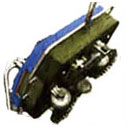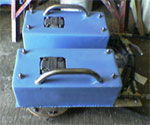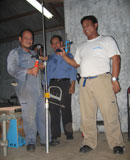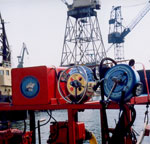| |
Mechanical brushes
Currently, in most cases, in the periods of time between the dry docking, the vessels are being cleaned by means of metallic or fosta nylon hydraulically driven rotating brushes, being devices of the “floor polisher” type. |
| |
|
Small systems of the mechanical brushes are used only for the local cleaning of the small areas, and in practice are not used for the industrial purposes. For the large “Floor polishers”, besides their significant weight, which may achieve 1.5 tons, and even bigger weight of the autonomously separated hydraulic pump stations, which put them in motion, cleaning by means of mechanical brushes has other substantial disadvantages: |
 |
| |
|
 |
- Absence of the unified manufacturing and industrial systems
- Damaging expensive anti-corrosive & antifouling paint and varnish coating due to mechanical rubbing contact of the instrument with the surfaces being treated.
|
- Often replacement of the brushes, resulting in the high time and material expenses
- Low efficiency or impossibility to clean off the long algae and thick hard fouling
- Impossible to clean cylindrical or curvilinear surfaces - strengthening ribs, vanes, lattices, adapting rings, hard-to-come voids and surfaces
- Using environmentally unfriendly hydraulic oil pumps and hoses
- Cleaning equipment and hydraulic oil drives’ unhandiness and costliness
- High risk of divers’ injury - the cleaning is restricted by the temperature and weather conditions
|
Currently, according to the new environmental safety norms, most of European countries get this type of cleaning banned |
| |
Hydropercussion treatment and hand scrapers
In case of impose of such restrictions like the shape of the surfaces treated (curvilinear and cylindrical surfaces of small diameter, environmental friendliness, fire safety) using the mechanical brushes becomes impossible, e.g. for cleaning the oil recovery complex platforms. |
 |
In this case, to clean the underwater surfaces usual or modified high-pressure equipment being similar to that used for washing cars, but significantly exceeding them on dimensions. Due to significant damping of the high-pressure blow under the water, productivity of such cleaning process becomes comparable with the manual cleaning by means of scrapers, and of course, has some essential disadvantages:
- A very low productivity
- Equipment bulkiness and inconvenience for the divers’
- Restricted ability for hard & thick fouling and long algae removal
- Big dimensions, weight and expensiveness of the pumps
- Damaging the surfaces being treated by manual scrapers cleaning
- Principal absence of the new technological solutions

|
Using the advanced CAVI – JET SYSTEMS AND COMPLEXES destined for the high-speed effective and high-quality cleaning of the surfaces of any shape and dimensions from the contamination and fouling of any thickness and structure allows removing any restrictions being specific to the traditional ways of cleaning. |
|